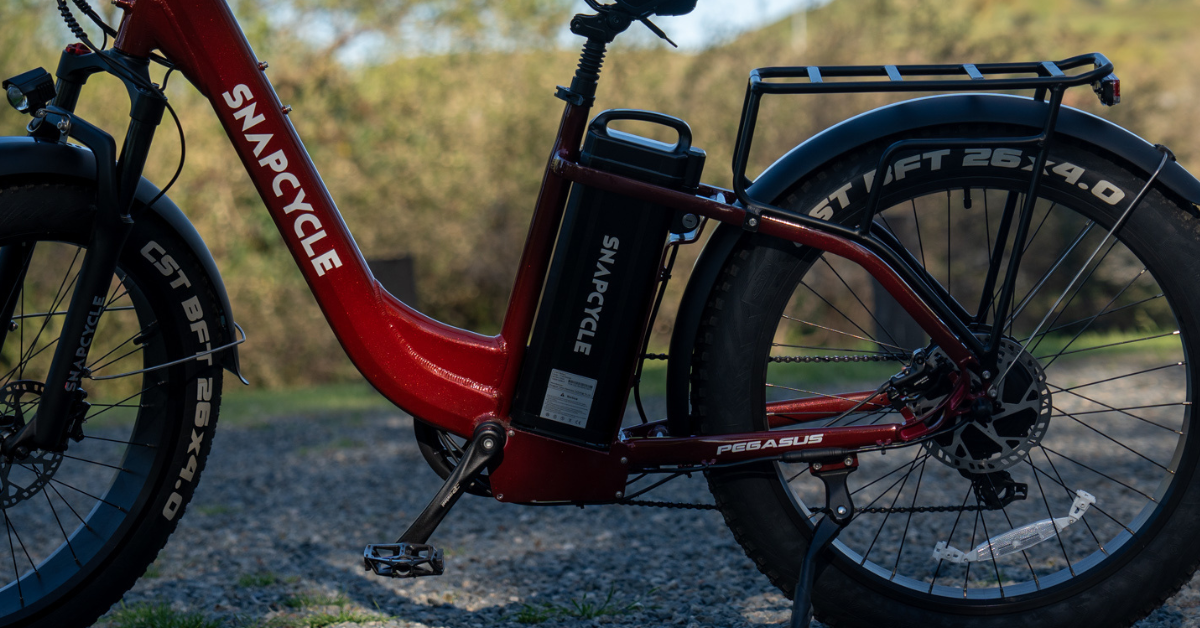There are a number of reasons why it’s smart for you to understand the amperage of an ebike. With this, you can tell what the required battery size is, how long it will take you to charge your ebike, and how the ebike will perform for you. The voltage of a 500-watt ebike depends on amperage.
General Formula To Calculate No. Of Amps That Any Ebike Draws
The formula to calculate the amperage of an ebike is as follows:
Amps = Power (Watts) / Voltage (Volts)
The formula is based on Ohm's Law, which states that an electric current (amperage) through a conductor between two points is directly proportional to the voltage applied to the conductor between the two points. In other words, the more voltage, the more current for a given constant resistance.
Calculation Of Amps That A 500-Watt Ebike Draws
Firstly, you need to know its operating voltage to determine the amperage draw of a 500-watt ebike. In the formula to find amperage, we use Amps = Watts / Volts.
For instance, a 500-watt ebike that runs on a battery of 48 volts will have a current draw of approximately 10.42 amps, which is 500 watts/ 48 volts. This calculation gives us an average amperage draw. Factual amperage fluctuates because of things like eBike ride conditions, assistance levels and motor efficacy.
How many types of voltage variations are there in the ebike?
E-bikes typically come in three common voltage levels:
- 36V: This is a pretty typical voltage for entry-level and city commuter ebikes, promising a great mid-way between power and range.
- 48V: This is the most popular voltage, which brings high power at your disposal and speed for hilly and extended terrain. Buy PEGASUS Ebike Battery online.
- 52V: It’s a newer and increasingly popular option that provides even more power and range for power-hungry riders or off-road adventures.
- 72V: Often used for Off-Road / Very High Powered electric bikes or for higher speed.
What voltage will suit you best will be determined by your riding style, terrain, and what type of performance you wish to receive. Higher powered and speedier operation is offered by higher voltages, but so too is a higher price tag.
How many wattage variations are there in ebike other than 500 watts?
- 250W: The most common wattage is found in entry-level and city e-bikes. It provides reasonable help on level territory and light slants.
- 350W: This is a good balance of power and efficiency, a great wattage for most riders riding most of the time. Some regions often make this the maximum legal limit.
- 750W+: These are serious off-road, able to conquer steep inclines and beat the crap out of some pretty rough terrain. But in some areas, they may be legally restricted.
Why Calculating the amperage of an ebike important?
There are multiple reasons why it’s important to calculate the amperage of an ebike. First of all, it contributes to determining the motor power output and, thus, acceleration quality and climbing capability of the hill, as well as vehicle performance as a whole. Then, it helps to choose the ebike battery capacity and to provide a sound charging infrastructure to support a reasonable range and safe charging. And charging infrastructure, ensuring adequate range and safe charging.
Thirdly, knowing how much amperage it draws can help identify problem spots — for example, excessive current draw is bad for the battery as it will both reduce its lifetime and can be dangerous. Therefore, finally, I am able to understand amperage helps when troubleshooting electrical problems and keeping the ebike system safe and working properly.
5 Examples To Calculate The Amperage Of The Ebike
How big of a battery do you need in the first place? To understand that, you need to figure out what size battery can provide you with an adequate amount of amperage draw for your ebike to function properly. Using the formula Amps = Power (Watts) / Voltage (Volts), we can work out current flow for a range of ebike configurations.
Case 1: Entry-Level Ebike
- Voltage: 36V
- Motor Power: 250W
- Amperage: 6.94A
36V, 250W for entry-level and casual riding and urban commuting. These bikes are great because they have nice performance, balance well with affordability, and are suitable for flat commutes or light recreational riding. Because the power and voltage are lower, they make for a smoother, more manageable ride. Hence, they were perfect for a beginner like me.
Case 2: Mid-Range Ebike
- Voltage: 48V
- Motor Power: 500W
- Amperage: 10.42A
45% more powerful ebikes than entry-level models with 48V batteries and 500W motors give a solid power and range boost. Visit Snapcycle to buy R1 battery. They're able to comfortably deal with moderate hills and provide a more spirited riding. These bikes are also good for a wider range of riders and riding conditions — longer commutes and light off-road adventures.
Case 3: High-Power Ebike
- Voltage: 72V
- Motor Power: 1000W (1kW)
- Amperage: 13.89A
The design is for serious riders with 72V batteries and 1000W motors for asking terrain. With impressive acceleration, top speeds and ease when conquering steep hills, mini jet skis are a favourite. These bikes are typically raced off-road and used for long-distance touring or high-speed commuting.
Case 4: Off-Road Ebike
- Voltage: 52V
- Motor Power: 750W
- Amperage: 14.42A
Mostly in terms of power and torque, off-road ebikes require 52V batteries and 750W motors to be able to ride the tougher trails. And many of them also have suspension, wider tyres and tougher frames to deal with the rough stuff. Mountain biking, gravel riding, and embarking on off-the-beaten-path adventures are all ideal down these bikes.
Case 5: Compact City Ebike
- Voltage: 24V
- Motor Power: 150W
- Amperage: 6.25A
These ebikes with 24-volt batteries and 150-watt motors are compact city ebikes aimed at urban commuting or short trips. Lightweight, easy to manoeuvre and sometimes foldable for storage. With lower power and voltage, they give a gentle assist that would appeal to riders who want a more relaxed and less powerful ride.
How To Extend E-Bike Battery Life and Maximize Its Efficiency?
To get quality e-bike batteries, you should go with the best ebike retailer like Snapcycle while buying a Bike. It’s not just about the type of components you choose to use in your system, either; you also need to take proper care of them. To extend the average life of your eBike battery, you should follow the following instructions:
- Charge the battery On Time: Twice during the day, you will want to recharge the battery before it drops below 20% to help reduce stress on the cells.
- Charge the battery with the best charger: Using a charger that’s designed for the voltage and capacity of your battery will provide proper battery charging cycles. Snapcycle brand is not only a source of High quality and discounted e-bikes but also a supplier of ebike spare parts and e-bike accessories.
- Taking moderate temperature conditions for the battery: Performance and lifecycle degrade with extreme heat or cold.
- Riding the E-bike Wisely: Stable acceleration and constant speeds lead to as few power spikes as possible, which improves efficiency and range.
By including these steps, it’s not only your battery life that will prolong, but your overall performance as well, so your eBike won’t only be your reliable but efficient way of getting from point A to B.
Conclusion
The wattage of eBike motors informs you how much current they require depending upon eBike models, and this is your starting point for selecting the battery that will support your motor and ensure your system is compatible. However, it’s the interplay between voltage, current and capacity that governs the efficiency with which your eBike performs.
Regardless, knowing all these things helps you when you’re configuring a new setup or upgrading from an existing system that you know is starting to peak for a little bit of extra pop or to see how far you can push your hardware. If you set your eBike up correctly, you’ll get reliable power for every ride during eBiking.
FAQs
How to calculate the peak motor amperage of an ebike?
Peak motor amperage is the maximum electrical current drawn by the motor.
- Formula: Peak Amperage (A) = Peak Power (W) / Voltage (V)
- Example: A 500W motor on a 36V battery: 500W / 36V = 13.89A (approx.)
How to calculate the peak motor power of an ebike?
Peak motor power is the maximum output the motor can deliver.
- Formula: Peak Power (W) = Voltage (V) * Peak Amperage (A)
- Example: A 36V battery with 15A peak current: 36V * 15A = 540W
What is the average cost of a 500-watt ebike?
Determining the price of an ebike is not a cup of tea. The reason it’s not an easy comparison is that the average cost of a 500W ebike can be anywhere from very cheap to moderate, too expensive, depending on brand, features, battery and build quality. But most of them are $1,500 or $3,000 and beyond.
What is the voltage and amperage of a 500-watt ebike?
For a 500-watt ebike, 36V and 48V are common voltage Options. This high voltage also typically means higher speed, which can help with hill climbing. But as far as talking about the amperage, that relies on the voltage. In order to get the same power for a 48V 500W ebike, that bike will have a higher amperage compared to a 36V 500W ebike.
What are other best power options for an ebike than 500 watts?
Some of the best power alternatives for a 500-watt ebike are as Follows:
- 250W
- 750W
- 1000W
Also Read: A Comprehensive Guide to Maintaining Your Snapcycle Ebike
Also Read: The Health Benefits of Riding an Ebike: Why It's More Than Just Fun

